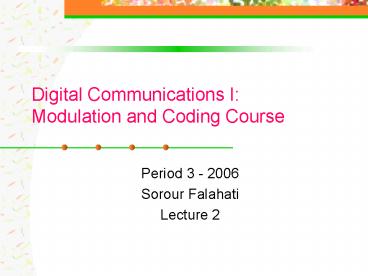Digital Communications I: Modulation and Coding Course - PowerPoint PPT Presentation
1 / 23
Title:
Digital Communications I: Modulation and Coding Course
Description:
Today, we are going to talk about: The first important step in any DCS: ... They Reminisce Over You. 2006-01-26. Lecture 2. 18. Baseband transmission ... – PowerPoint PPT presentation
Number of Views:210
Avg rating:3.0/5.0
Title: Digital Communications I: Modulation and Coding Course
1
Digital Communications IModulation and Coding
Course
- Period 3 - 2006
- Sorour Falahati
- Lecture 2
2
Last time, we talked about
- Important features of digital communication
systems - Some basic concepts and definitions as signal
classification, spectral density, random process,
linear systems and signal bandwidth.
3
Today, we are going to talk about
- The first important step in any DCS
- Transforming the information source to a form
compatible with a digital system
4
Formatting and transmission of baseband signal
5
Format analog signals
- To transform an analog waveform into a form that
is compatible with a digital communication, the
following steps are taken - Sampling
- Quantization and encoding
- Baseband transmission
6
Sampling
Time domain
Frequency domain
7
Aliasing effect
8
Sampling theorem
- Sampling theorem A bandlimited signal with no
spectral components beyond , can be uniquely
determined by values sampled at uniform intervals
of - The sampling rate, is called
Nyquist rate.
9
Quantization
- Amplitude quantizing Mapping samples of a
continuous amplitude waveform to a finite set of
amplitudes.
- Average quantization noise power
- Signal peak power
- Signal power to average quantization noise power
10
Encoding (PCM)
- A uniform linear quantizer is called Pulse Code
Modulation (PCM). - Pulse code modulation (PCM) Encoding the
quantized signals into a digital word (PCM word
or codeword). - Each quantized sample is digitally encoded into
an l bits codeword where L in the number of
quantization levels and
11
Qunatization example
amplitude x(t)
111 3.1867
110 2.2762
101 1.3657
100 0.4552
011 -0.4552
010 -1.3657
001 -2.2762
000 -3.1867
Ts sampling time
t
PCM codeword
110 110 111 110 100 010 011 100
100 011
PCM sequence
12
Quantization error
- Quantizing error The difference between the
input and output of a quantizer
13
Quantization error
- Quantizing error
- Granular or linear errors happen for inputs
within the dynamic range of quantizer - Saturation errors happen for inputs outside the
dynamic range of quantizer - Saturation errors are larger than linear errors
- Saturation errors can be avoided by proper tuning
of AGC - Quantization noise variance
14
Uniform and non-uniform quant.
- Uniform (linear) quantizing
- No assumption about amplitude statistics and
correlation properties of the input. - Not using the user-related specifications
- Robust to small changes in input statistic by not
finely tuned to a specific set of input
parameters - Simply implemented
- Application of linear quantizer
- Signal processing, graphic and display
applications, process control applications - Non-uniform quantizing
- Using the input statistics to tune quantizer
parameters - Larger SNR than uniform quantizing with same
number of levels - Non-uniform intervals in the dynamic range with
same quantization noise variance - Application of non-uniform quantizer
- Commonly used for speech
15
Non-uniform quantization
- It is done by uniformly quantizing the
compressed signal. - At the receiver, an inverse compression
characteristic, called expansion is employed to
avoid signal distortion.
Compress
Qauntize
Expand
Channel
Transmitter
Receiver
16
Statistical of speech amplitudes
- In speech, weak signals are more frequent than
strong ones. - Using equal step sizes (uniform quantizer) gives
low for weak signals and high for
strong signals. - Adjusting the step size of the quantizer by
taking into account the speech statistics
improves the SNR for the input range.
17
Quantization demo.
Uniform Quantizer
2-bits Q.
3-bits Q.
4-bits Q.
Non-Uniform Quantizer
2-bits Q.
3-bits Q.
Pete Rock They Reminisce Over You
4-bits Q.
18
Baseband transmission
- To transmit information through physical
channels, PCM sequences (codewords) are
transformed to pulses (waveforms). - Each waveform carries a symbol from a set of size
M. - Each transmit symbol represents
bits of the PCM words. - PCM waveforms (line codes) are used for binary
symbols (M2). - M-ary pulse modulation are used for non-binary
symbols (Mgt2).
19
PCM waveforms
- PCM waveforms category
- Phase encoded
- Multilevel binary
- Nonreturn-to-zero (NRZ)
- Return-to-zero (RZ)
20
PCM waveforms
- Criteria for comparing and selecting PCM
waveforms - Spectral characteristics (power spectral density
and bandwidth efficiency) - Bit synchronization capability
- Error detection capability
- Interference and noise immunity
- Implementation cost and complexity
21
Spectra of PCM waveforms
22
M-ary pulse modulation
- M-ary pulse modulations category
- M-ary pulse-amplitude modulation (PAM)
- M-ary pulse-position modulation (PPM)
- M-ary pulse-duration modulation (PDM)
- M-ary PAM is a multi-level signaling where each
symbol takes one of the M allowable amplitude
levels, each representing bits
of PCM words. - For a given data rate, M-ary PAM (Mgt2) requires
less bandwidth than binary PCM. - For a given average pulse power, binary PCM is
easier to detect than M-ary PAM (Mgt2).
23
PAM example































